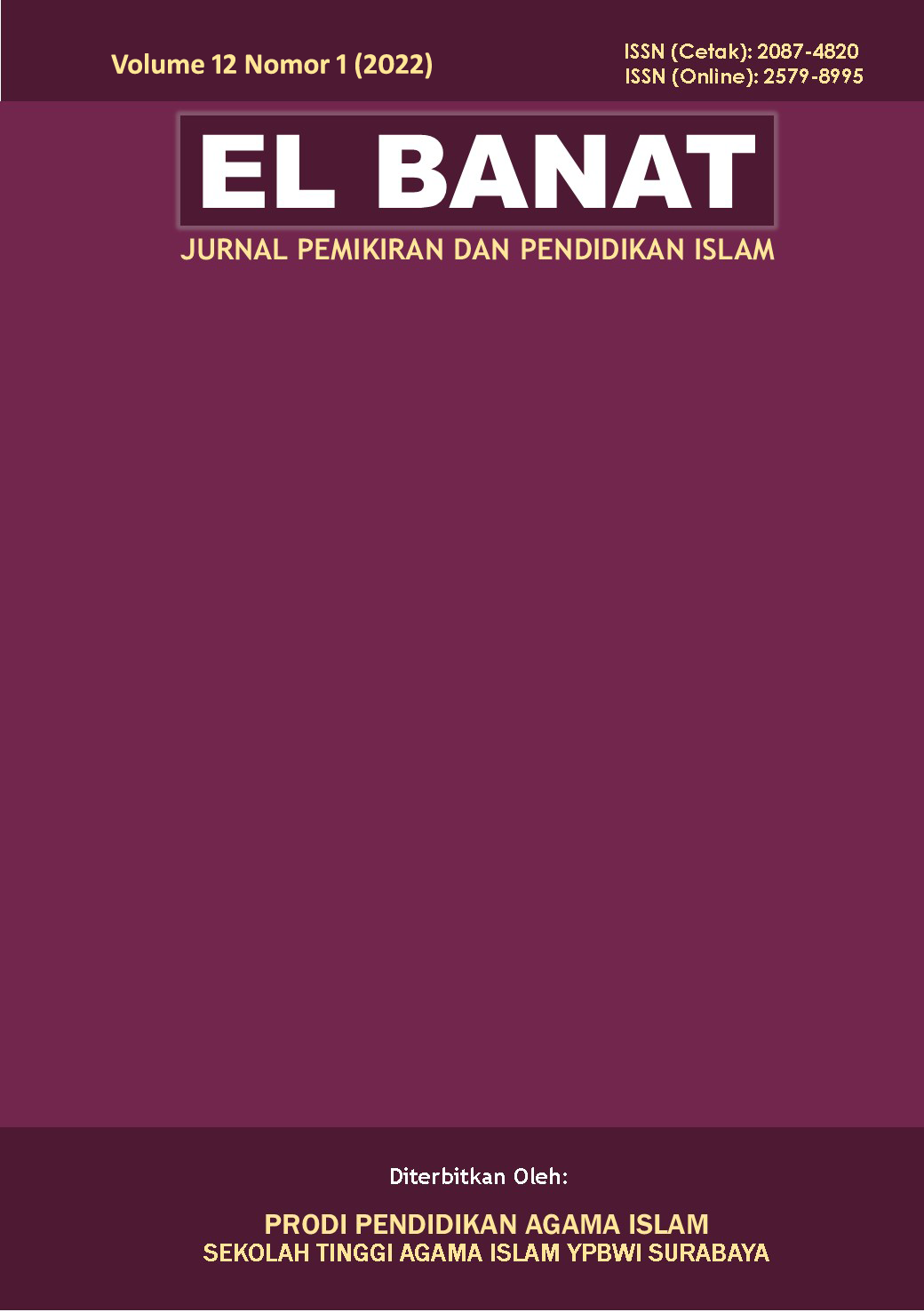Penerapan Model Pembelajaran Flipped Classroom dalam Meningkatkan Kemampuan Berpikir Kritis Siswa pada Mata Pelajaran Pendidikan Agama Islam
DOI:
https://doi.org/10.54180/elbanat.2022.12.1.87-103Keywords:
Flipped Classroom Learning Model, Students Critical Thinking Ability, PAI SubjectsAbstract
The flow of digital developments has a positive impact on education. Therefore, teachers and students can collaborate in presenting creative and innovative learning that encourages the
realization of critical thinking skills in students. This applies to every subject, including the subject of Islamic Religious Education (PAI). This study aims to explain the effectiveness of
applying the flipped classroom learning model to increasing students' critical thinking skills in PAI subjects in class XII MIPA SMA Negeri 1 Krembung Sidoarjo. The research method used is the experimental method with the One Group Pretest-Posttest design to explain students' critical thinking skills after applying the flipped classroom learning model. The results of the study show that the application of the flipped classroom learning model has effectiveness in increasing the critical thinking skills of class XII MIPA students in PAI subjects. This is evidenced by the results of the Sig. (2-tailed) which is equal to 0.000. This value indicates (less than) <0.05 of the significance level in the Paired Sample T-Test. Therefore, the flipped classroom learning model can be recommended for its application to improve students' critical thinking skills in PAI subjects at school
Downloads
References
Aziz, Romisty. Aspek-Aspek Pendidikan Dari Kisah Maryam Dalam Al-Qur’an. Makassar: Alauddin University Press, 2011.
Huriyah, Lilik., dkk., “Quo Vadis Higher Order Thinking Skills (HOTS) pada Soal UM PTKIN Materi Pendidikan Agama Islam”, Jurnal Pendidikan Agama Islam (Journal of Islamic Education Studies), Vol. 8 No. 2 (2020): 133-152.
Imas Kurniasih & Berlin Sani. Ragam Pengembangan Model Pembelajaran untuk Peningkatan Profesionalitas Guru. Yogyakarta: Kata Pena, 2015.
Kholid, Idmam. Analisis Kemampuan Berpikir Kritis dalam Pemecahan Masalah. Malang: Skripsi, 2018.
Paul, Richard & Linda Elder. “Critical Thinking Development : A Stage Theory with Implications for Instruction” dalam
http://www.critichalthinking.org/,(diakses pada 28 Januari 2022, pukul 22.00 WIB).
Raihani. “A Model Of Islamic Teacher Education For Social Justice In Indonesia: A Critical Pedagogy Perspective”. Journal Of Indonesian Islam, Vol. 14, No. 1 (Juni 2020).
Roma P. Yulias, Richardus Eko I.. Flipped Classroom. Yogyakarta: ANDI, 2021.
Rusydiyah, Evi Fatimatur., AR, Zaini Tamin., Rahman, Moh Rifqi. “Literacy policy in southeast Asia: a comparative Study between Singapore, Malaysia, and Indonesia”, Center for Educational Policy Studies Journal (2022). DOI: https://doi.org/10.26529/cepsj.1214.
Sanjaya, Wina. Strategi Pembelajaran Berorientasi Standar Proses Pendidikan. Jakarta: Kencana Prenademedia Group, 2006.
Sapriya. Pendidikan IPS: Konsep dan Pembelajaran. Bandung: PT Remaja Rosdakarya, 2011.
Subagyo, P. Joko. Metode Penelitian dalam Teori dan Praktek. Jakarta: PT Rineka Cipta, 1994.
Sugiyono. Metode Penelitian Kuantitatif, Kualitatif, dan R&D. Bandung: Alfabeta, 2012.
Sugiyono. Metode Penelitian Pendidikan. Bandung: Alfabeta, 2016.
Sunaryo, Wowo. Taksonomi Berpikir. Bandung: PT. Remaja Rosdakarya, 2011.
Taroreh, Berlinda. Profil Kemampuan Pemecahan Masalah dan Keaktfan Siswa dalam Pembelajaran Flipped Classroom pada Materi Pertidaksamaan Rasional. ISSN 2613-9186, Vol. 3 No. 1. 2020.
Trianto. Model-Model Pembelajaran Inovatif Berorientasi Kontruktivsitik. Jakarta: Prestasi Pustaka, 2013.
Trianto. Pengantar Penelitian Pendidikan bagi Pengembangan Profesi Pendidikan dan Tenaga Kependidikan. Jakarta: Kencana, 2011.
Wulandari, Mega, “Konsep Dasar Metode Flipped Classroom” https://www.usd.ac.id/pusat/ppip/2020/05/04/konsep dasar-metode
flipped-classroom, (diakses pada 26 Januari 2022, pukul 22.00 WIB).





